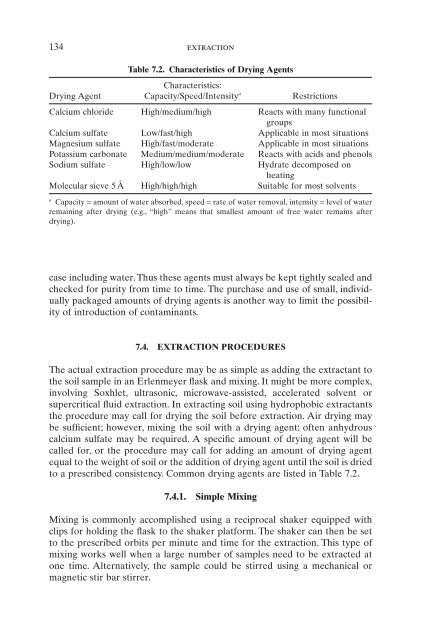Introduction to Soil Chemistry
Introduction to Soil Chemistry
Introduction to Soil Chemistry
You also want an ePaper? Increase the reach of your titles
YUMPU automatically turns print PDFs into web optimized ePapers that Google loves.
134 extraction<br />
Table 7.2. Characteristics of Drying Agents<br />
Characteristics:<br />
Drying Agent Capacity/Speed/Intensity a<br />
Restrictions<br />
Calcium chloride High/medium/high Reacts with many functional<br />
groups<br />
Calcium sulfate Low/fast/high Applicable in most situations<br />
Magnesium sulfate High/fast/moderate Applicable in most situations<br />
Potassium carbonate Medium/medium/moderate Reacts with acids and phenols<br />
Sodium sulfate High/low/low Hydrate decomposed on<br />
heating<br />
Molecular sieve 5Å High/high/high Suitable for most solvents<br />
a Capacity = amount of water absorbed, speed = rate of water removal, intensity = level of water<br />
remaining after drying (e.g., “high” means that smallest amount of free water remains after<br />
drying).<br />
case including water. Thus these agents must always be kept tightly sealed and<br />
checked for purity from time <strong>to</strong> time. The purchase and use of small, individually<br />
packaged amounts of drying agents is another way <strong>to</strong> limit the possibility<br />
of introduction of contaminants.<br />
7.4. EXTRACTION PROCEDURES<br />
The actual extraction procedure may be as simple as adding the extractant <strong>to</strong><br />
the soil sample in an Erlenmeyer flask and mixing. It might be more complex,<br />
involving Soxhlet, ultrasonic, microwave-assisted, accelerated solvent or<br />
supercritical fluid extraction. In extracting soil using hydrophobic extractants<br />
the procedure may call for drying the soil before extraction. Air drying may<br />
be sufficient; however, mixing the soil with a drying agent; often anhydrous<br />
calcium sulfate may be required. A specific amount of drying agent will be<br />
called for, or the procedure may call for adding an amount of drying agent<br />
equal <strong>to</strong> the weight of soil or the addition of drying agent until the soil is dried<br />
<strong>to</strong> a prescribed consistency. Common drying agents are listed in Table 7.2.<br />
7.4.1. Simple Mixing<br />
Mixing is commonly accomplished using a reciprocal shaker equipped with<br />
clips for holding the flask <strong>to</strong> the shaker platform. The shaker can then be set<br />
<strong>to</strong> the prescribed orbits per minute and time for the extraction. This type of<br />
mixing works well when a large number of samples need <strong>to</strong> be extracted at<br />
one time. Alternatively, the sample could be stirred using a mechanical or<br />
magnetic stir bar stirrer.
















